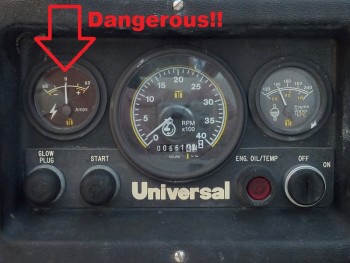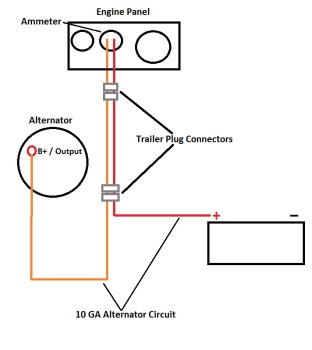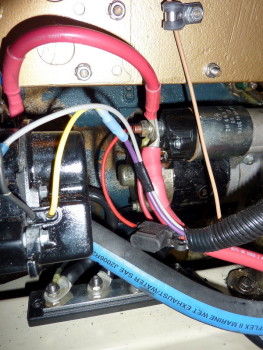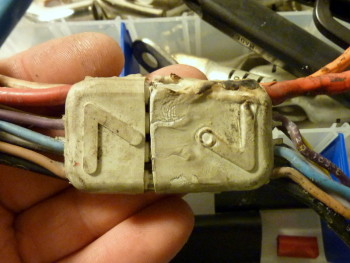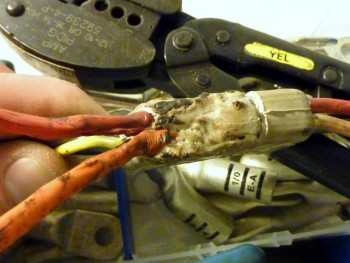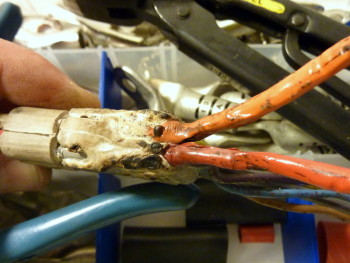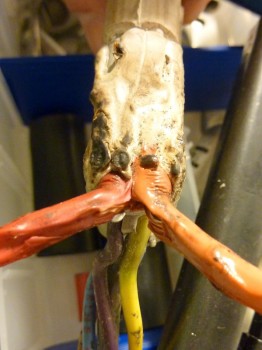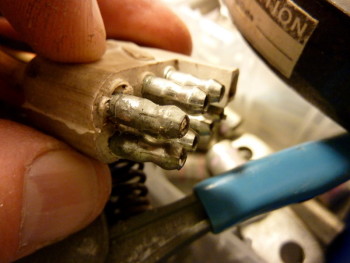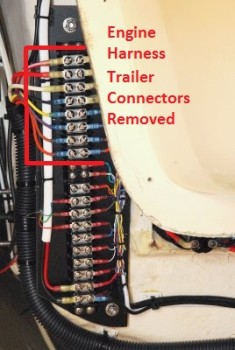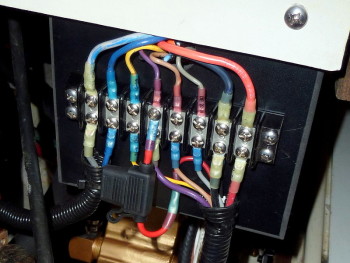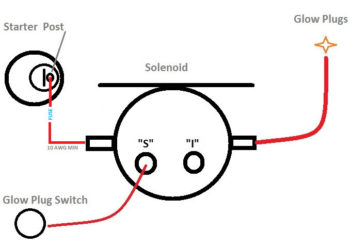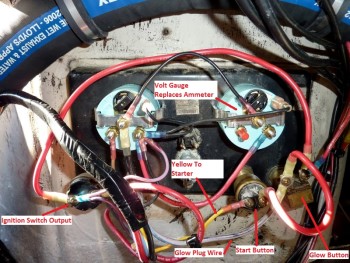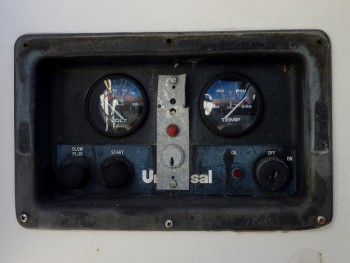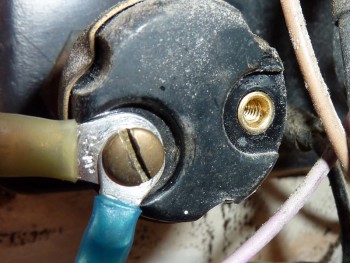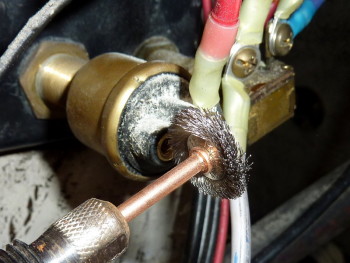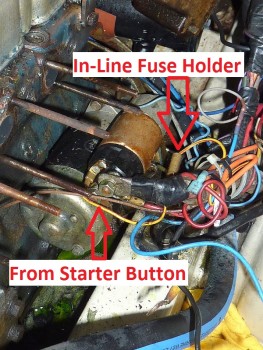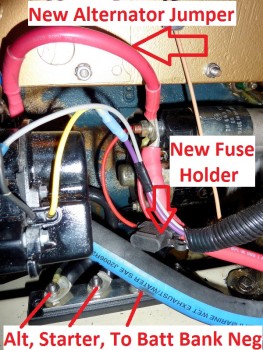Engine Panel With Ammeter = Dangerous
If your Universal engine panel looks like this, and has an ammeter, you are due for some critically important wiring upgrades.
The factory wiring, with an ammeter in the panel, is flat out dangerous and this wiring mess really needs to be addressed. It amazes me how many boats are out there still using this amazingly unsafe set up.
IMPORTANT: If you have an ammeter in your engine panel remove it and jumper your alternator 6″ over to the starter post with heavy wire. Another alternative is to run your alternator direct to the house bank with a fuse or breaker within 7″ of the battery and then add a combining relay or Echo Charger.
I have physically measured voltage drops of 1.2V volts or more at just 10A of charge current through these circuits. That means your alt is putting out 14.2V+ and the battery is seeing just 13.0 volts and is being chronically under charged. At higher charging currents this resistance creates heat and can literally lead to a boat fire.
Early Universal Engine Charging Circuit
Here’s a very crude diagram that shows the alternator charging circuit most often found on these early Universal diesel engines. Universal/Westerbeke Corporation later changed this incredibly dangerous set up, removed the ammeter and jumped the alternator directly to the starter lug. Interestingly enough most of the Westerbeke engines never used a factory installed ammeter and it was only sold as an option.
Why is the ammeter so dangerous?
It is not necessarily the ammeter itself that is dangerous but rather the wiring circuit and the type of use a marine alternator is put through.
The Ammeter Circuit:
The dangerous factory charging circuit leaves the alternator output stud with the orange wire This grossly undersized wire is carrying what ever current the alternator is capable of producing, normally upwards of 50A -55A but occasionally a 72A alternator was installed as an option. Along the circuit path it most often travels through not one, but two, trailer type connectors before the charging current even gets to the ammeter mounted in the engine panel.
This high amperage charging current then has to travel all the way back to the starter motor stud, back through the trailer plugs and back through more undersized wire. Finally back at the stater motor stud it finally picks up large gauge wire at the starter motor before finally heading to the battery to charge it.
Some of these factory circuits had a 30A fuse in them, which was undersized even for some of the alternators shipped on these engines. Nuisance trips were pretty common in these harnesses. Owners often wound up installing higher amp fuses in or simply bypassed them all together, which is unwise.
The existing alternator charging circuit, consisting of the orange & red 10GA wires, runs as far as 25+ feet on some boats before it gets to the battery banks. On most of these panels the entire current of the alternator runs through upwards of 25′ of 10GA wire and two ridiculously pathetic trailer type connectors, for this type of load. The undersized wire and trailer connectors trying to pass 45A+ creates a large amount of resistance as these boats age. I’ve pulled many of these trailer connectors and wires out that were literally melted, as you’ll see.
With house bank energy demands getting larger and larger and battery banks getting bigger and bigger, accepting significantly more charging current, these circuits have been known to literally melt down and in some cases catch fire!
What I just mentioned happens easily with the stock factory alternators yet I have seen DIY upgrades to 100A + alternators still utilizing this circuit.
PLEASE DO NOT DO THIS!!!
Bypass The Orange & Red Alternator Circuit
Here’s the quick and dirty fix. Try to focus on the red wire between the back of the alternator and the starter post. Simply jump the alternator output to the starter post and disconnect the orange wire. With this jumper the alternator output bypasses the 25+/- feet of teeny tiny 10GA wire and uses the large gauge starter wire to make its way back to the battery switch and then to the battery banks. This results in minimal voltage drop compared to the 10GA circuit and much less resistance and heat without going through all that small wire and two trailer connectors.
NOTE: For this short of a jumper, between the alternator B+ & starter post, you do not need wire this large. I used this because it made it easy to see and larger wire never hurts.
IMPORTANT: I most cases I will generally advise running the alternator output directly to the house battery bank, not to the starter as shown here. You can then install an automatic combining relay (ACR) or an Echo Charger between the banks to charge both banks simultaneously. Doing this will remove the potential for fried diodes via the flipping of the battery switch through the OFF position and allow for better alternator performance and less voltage drop. While not 100% necessary on all installations it is a good upgrade.
Even if you choose not to run the alternator direct to the house battery bank you are far safer with this new jumper than you were before by pushing all that current through 25+ feet of 10GA wire.
The Notorious “Trailer Connector“
In all this mess, this is what you are looking for, the trailer connector. Once you find them, there are most often two of them in there, CUT THEM OUT!
These connectors can start fires!
Replace these connectors with a buss bar and ring terminals or butt splices. Either method will be far superior to the factory trailer plugs. These trailer type connectors were never intended nor designed to have 50+ amps running through them let alone the alternator upgrades I’ve seen pushing 75+ amps. This one is clearly melted as you see in the next few photos.
For charging batteries you want minimal voltage drop between the alternator output and the battery bank. For example a stock alternator with a 14.2V set point at 3% voltage drop would have the battery bank seeing about 13.8V. This type of volt drop can chronically undercharge your bank and can lead to premature sulfation and early battery bank death.
This particular boat had a 72A alternator and 22′ of orange and red 10GA wire before it hit the starter post. Even if we figure the 72A alt will never put out 72A, unless cold, and we base our calculation on just a 60A output, at a 3% volt drop this would require 4GA wire, NOT 10GA. If you want a 2% voltage drop you’d need 2GA wire and this is a far cry from 22′ of 10GA wire.
Boat Fire Narrowly Averted..
This came off a mid 80’s production boat with a 5416 Universal. The owner had no idea what had been lurking below under all that electrical tape.
I can not stress enough how important it is to bypass the factory charging circuit and REMOVE the trailer connectors.
Towering Inferno Anyone…..
I remember that move from the 70’s and would hate for that to become your boat. Let this image sink in.
Literally Fused Together..
These two wires got so hot they were physically melted together with jacket blistering and all. A few more deep discharges on this battery bank and this could have been a full blown burned to the water USCG statistic. This wiring fix for early Universal engines, with the ammeter panel, is not something to take lightly..
Just a Little Oxidation
Just a little oxidation is all it takes with these cheap connectors to cause resistance in a high amperage circuit. The two pins closest to you are the orange and red wire pins for the charging circuit. Note how clean the low current pins are in the back ground. As I mentioned these connectors are not safe to run this much amperage through.
Pin & Socket Amperage Ratings??
Out of curiosity I contacted three different manufacturers of this type of pin & socket configuration, Hopkins, Pollak and Peterson. In all three cases I was told the maximum continuous rating for this type of pin is approx 7.5A. One company told me 7.5A continuous and 15A for short duration’s like brake lights or flashers but the bottom line is that this very popular male female pin/socket, the same exact type Universal / Westerbeke used to pass 50A plus of alternator current is apparently only rated for 7.5A and perhaps 15A for very short duration’s. Are we beginning to see how bad this problem really is?
Universal apparently decided on their own that it was safe to push 50A+ through these small pins. Wow!! On top of the trailer plug blunder a 10GA wire in a bundle like these wiring harnesses are in, and in an engine space, is not even rated to handle 50A of current under the ABYC safety standards.
This wiring harness and alternator path was such an f’ing blunder from the start it’s not even laughable. Heck you could have given a group of third-graders a class project on wiring an alternator and they would have done a significantly safer job than Universal/Westerbeke did here. Can you say cluster-f@ck……
How To Remove The Trailer Plugs
On this particular boat I simply used heat shrink ring terminals and a Blue Sea busbar. This connector did not have any high current running through it, as this was on a later Westerbeke, but I still remove the problematic and quirky trailer connectors as I find they are very poorly suited for the marine environment. Even without any high current circuits, like an alternator or glow plugs, they can still cause issues.
These heat shrink rings create a significantly more reliable and better connection. Once coated with BoeShield, No-Ox-Id Special A, or a similar corrosion protection product the electrical gremlins are now virtually a non-issue.
Another Trailer Connector Removed
Here’s another example of a trailer connector that has been removed and replaced with a Blue Sea terminal strip, ring terminals and adhesive lined heat shrink terminals.
What About The High Amp Glow Plug Circuit?
The other high amp circuit on these earlier engines is the glow plug circuit. While the two cylinder engines may do just fine with a 10GA circuit the three and four cylinder engines can suffer from “slow glow” and shortened ignition switch or glow button life as they are often not rated for 35-40A..
A very quick and easy way to fix this is to insert a simple heavy duty solenoid into the glow plug circuit. To install this solenoid you simply steal power via a 10GA wire from the starter post. Please be sure to fuse this run as close to the starter post as possible.
You then snip the glow plug wire, add ring terminals, and place the glow plug end on the opposite side of the solenoid from the starter wire and the glow plug switch end goes to the “S” terminal.
Now when you hit the glow plug button a the solenoid closes and creates a direct path between the high current, large gauge, starter wires and the glow plugs. All the glow plug switch has to do is energize the solenoid coil which takes very little current. You are no longer running the glow plugs through 20+ feet of 10GA wire & switches not really intended for that type of connect & disconnect rating.
When replacing these ignition switches or pre-heat buttons be aware that some companies market ignition switches and momentary spring switches as high amperage. The sad reality as they are very often not “high amperage“. I pulled apart one such switch that claimed to be rated for 50A and it was an EXACT COPY of a Cole Hersee switch rated at 10A, only made in China and sold by a disreputable American comapny. When in doubt stick with Cole-Hersee for solenoids (model 24059 or similar), momentary switches, like the M-490, and ignition switches. They have been doing marine duty products longer than just about anyone. If you remove the alternator output from the harness, and install a glow solenoid, then even a light duty ignition switch and pre-heat switch will work fine.
All newer Universal and Westerbeke engines, with glow plugs, utilize a “preheat solenoid” and for good reason. You can buy a pre-heat/glow-plug solenoid from Cole-Hersee, such as the model 24059, for about $19.00 and save money. Do be sure that what ever solenoid you purchase is ignition protection (IP) rated.
IMPORTANT: When you do this upgrade please cut your glow button plug push-time to 7-15 seconds. If you hold for the duration you used to, with the old & dangerous wiring harness, you can literally cook your glow plugs..
Re-Wired Panel
This is one of the simple Universal panels with only a temp gauge and ammeter. They also make them with a tachometer, oil pressure, water temp & volt gauge. This one has been re-terminated and has been upgraded to a new temp gauge, Teleflex Amega Series, and volt gauge which replaced the ammeter. On this boat I installed a Teleflex Amega Series gauge for the volt meter as well.
I no longer use Teleflex gauges and have switched over to the Faria Euro Style gauges from Defender. Better pricing, better product support and a nice clean looking gauge. They also make a 0-4000 RPM diesel tachometer that can be driven from an alternator and the part number is 32842.
As you can see in the diagram the key switch energizes the glow plug button first. There is then a “series jumper” that ensures the glow plug button is pressed in order to energize the start button. Personally I usually leave this series jumper in place as I have found owners will usually try to bypass the glow and not do it if they think they can get away with it. If you don’t use glow, and the motor does not start, you are that much closer to filling your cylinders with water if the seacock was open.
If you feel brave and want to make the start button independent of the glow button simply move the jumper to the incoming side of the glow button, far right side, or jump to the outlet/on side of the key switch, far left. I don’t advise this and do not even do this on my own vessel as I know I will try and take a short cut some day and it may cost me.
The yellow wire with red trace is the starter solenoid wire that energizes the starter. It is a tad undersized from the factory so with any resistance in the circuit, from trailer connectors or the in-line fuse holder, this can cause solenoid engagement issues. Once the trailer connectors have been removed, the wire re-terminated and new fuse holder inserted these problems often vanish even with the yellow/red wire.
As I mentioned there is an in-line fuse in the yellow/red wire close to the solenoid. This fuse holder is famous for disintegrating and ideally should be replaced when you do this upgrade. If you want to, feel free to run a new wire from the start button to the solenoid, 12GA is sufficient, and add a new in-line fuse holder.
It should be mentioned that the starter solenoid circuit is a low amp circuit. At max they pull about 2A – 6A as measured on the in-rush or peak current draw for the circuit when hitting the starter button and capturing the in-rush with a Fluke DC clamp on DVM. This particular starter solenoid drew 2.3A. While the yellow wire can certainly handle the amp load for the circuit it is often the fuse holder or terminations that create enough resistance to cause even a low amp circuit like this some issues.
With some Universal engines I have seen the solenoid circuit wired with 14GA wire and some really early ones with 16GA wire. The 16GA wire, over a 20′ round trip circuit, 10 feet each way, has about 1.6% voltage drop and the 14GA wire is about 1% voltage drop. If we extend the circuit to 20 feet one way, or 40′ round trip we are at 3.2% voltage drop on 16GA wire and 2% voltage drop on 14GA wire. These are not bad voltage drop numbers but it you have the ability to re-use one of the other larger wires for this circuit, or run a new one, it will make your solenoid voltage drops even less.
Teleflex Amega Gauges
The new Teleflex Amega gauges are now installed. This panel only had ammeter and temperature. It now has volts and temperature. Teleflex & Faria temperature & oil pressure gauges will work with the senders on all Universal & Westerbeke engines.
Of course voltage is not specific to any boat so a volt meter will always work but the oil & temp gauges do work well and these gauges are far less money than buying them direct from Westerbeke/Universal.
Please don’t ask what that key, and hunk of steel in the middle is. Someone added it to this particular boat somewhere along the way. It is not factory and it was long ago disconnected. It does however keep the holes in the panel sealed, & the owner cared less, so I left it in-place.
When Re-terminating
When re-terminating the panel and wires it’s a good idea to clean any oxidation from the switches and stripped wires before re-terminating them. I use a rotary tool & Dremel brand stainless steel brush for this.
Dremel Brush
This is the Dremel brush I use. It is the stainless steel #530 wheel.
These Wires Had Been Fairly Oxidized
These wires, from the factory wiring harness, had been fairly oxidized. Cleaning them with the Dremel #530 wheel makes them clean enough for re-termination and creates a good, clean, copper to copper connection. The #530 SS wheel is stiff enough to get into the inner stranding, not just the outer strands. Occasionally you need to manually open or fan the strands out but it takes just a few seconds per wire, that’s it. Be sure to get all copper stranding as clean as possible or just replace the wires.
Once clean I use adhesive lined heat shrink crimp on ring terminals. This keeps moisture out and creates a sealed connection.
In a perfect world every one of these wires would be replaced with new but not all owners can afford that. Cleaning and re-terminating can be a reasonable alternative.
Don’t Forget The Starter End
Honestly, I’m not kidding, I can’t make this stuff up…..
Sadly this is the sort of rats nest I see almost every day. It’s truly amazing that electrical fires on boats only make up 55% of all boat fires, but I digress….
Everything you can see in this photo has to get fixed. None of it is suitable. The #1 issue with the starter on these engines is the yellow wire with the red tracer. Follow that wire from the starter solenoid over to the in-line fuse holder. These fuse holders were cheap junk. I often find them cracked, rusted and not allowing the engine to start. As I said the number one “no start” issue I see on Universal diesels is that in-line fuse holder. The fuse holder for starter excite in this location is not even needed. The only reason I ever replace them is because an ATC fuse holder makes great location for me to tap into the starter circuit with my remote start switch.
I replace these fuse holders with in-line ATC holders and they make a nice “emergency break” point for when a starter button sticks, and this can and does happen. Ideally the duration of a stuck starter would trip the fuse but they are often sized too large for this. I still often leave this fuse accessible just in case the starter button sticks or to use as a remote start switch tap in location for oil changes or service work..
All Cleaned Up
In this shot we can see the rats nest is mostly gone. I have directly routed the alternator to the starter post, large GA red wire, where it picks up the large battery cable going back to the “C” post of the battery switch. Alternatively, and preferably from a performance stand point, you can route the alternator output direct to the house bank and fuse the wire within 7″ of the positive battery post.
The crappy in-line fuse holder for the start switch circuit was replaced with one that is much more resistant to moisture, vibration & heat. If your start button sticks, as can happen, you will be glad you have this fuse. This fuse holder is also an ideal location for a hand-held remote start switch tap-in point, for oil changes, fuel filter changes etc. thus eliminating trips to the cockpit just to start the motor..
The panel feed wire, 10GA wire attached to large starter lug, is also fused using a MIDI fuse & holder not too far out of that photo. The factory never did fuse this wire and it’s a requirement under the ABYC safety standards.
I have also installed a neg battery bank bus bar on the engine bed stringer. A neg wire the same size as the alternator positive is connected directly to the alternator and then to the new negative bus bar.
The second wire from the left goes directly to the ear of the starter for the best possible negative return to the battery bank. I don’t like running hundreds of amps through a rusty engine, paint, corrosion and multiple dissimilar metals before it can go back to the batteries. This direct wiring to the starter ear creates less voltage drop and makes for a happy starter motor.
The third wire from the left, under the hose, runs directly back to the negative battery post and carries the alternator and starting currents.
Good luck & happy boating!!
Let’s Keep This Site Running!
Like what you saw or read? Would you like to see more articles like this? Is so feel free to donate, support the site and keep it growing. I am trying my hardest to keep this information FREE. If you liked it, learned from it or I saved you some money feel free to make a small donation, that’s all I ask.

